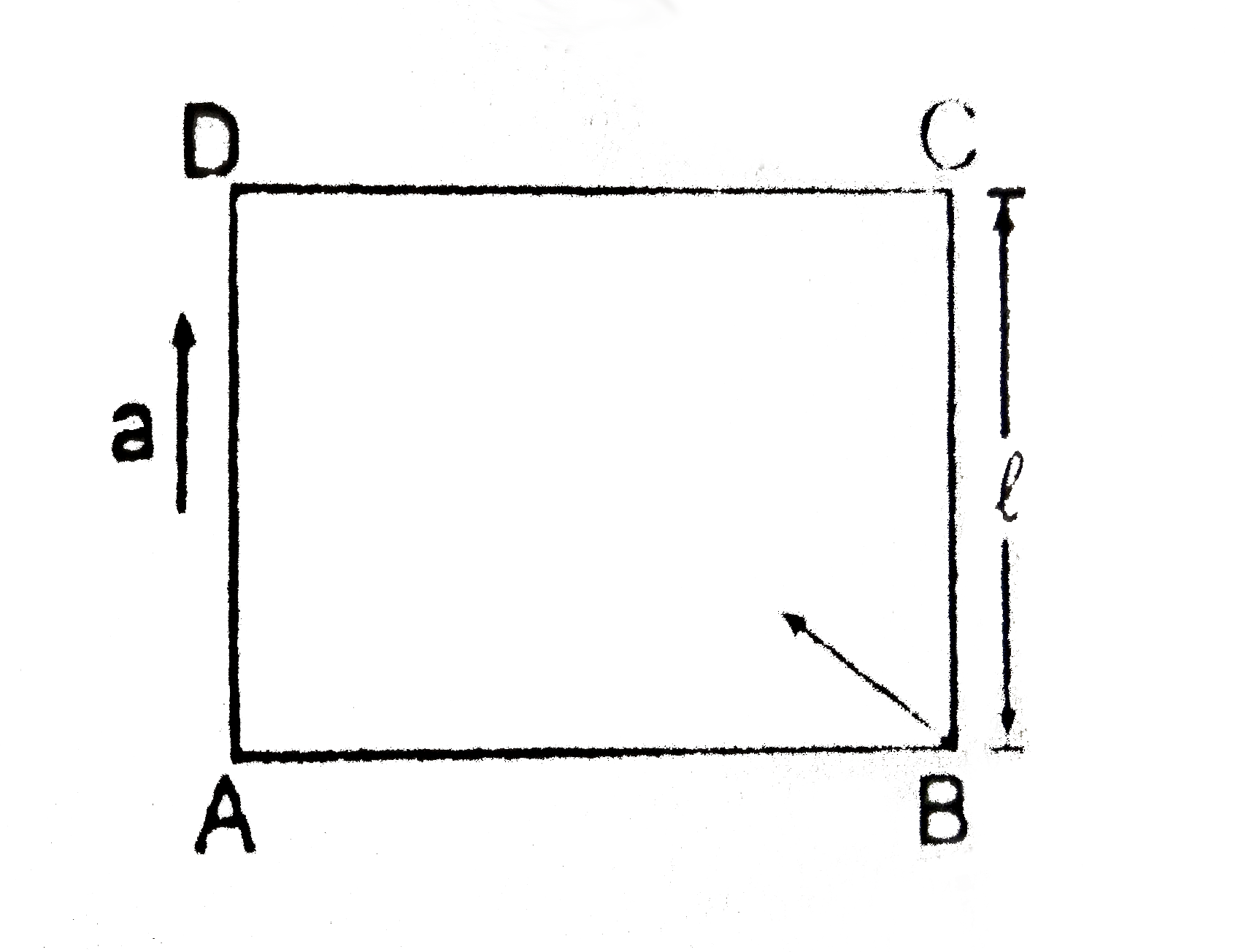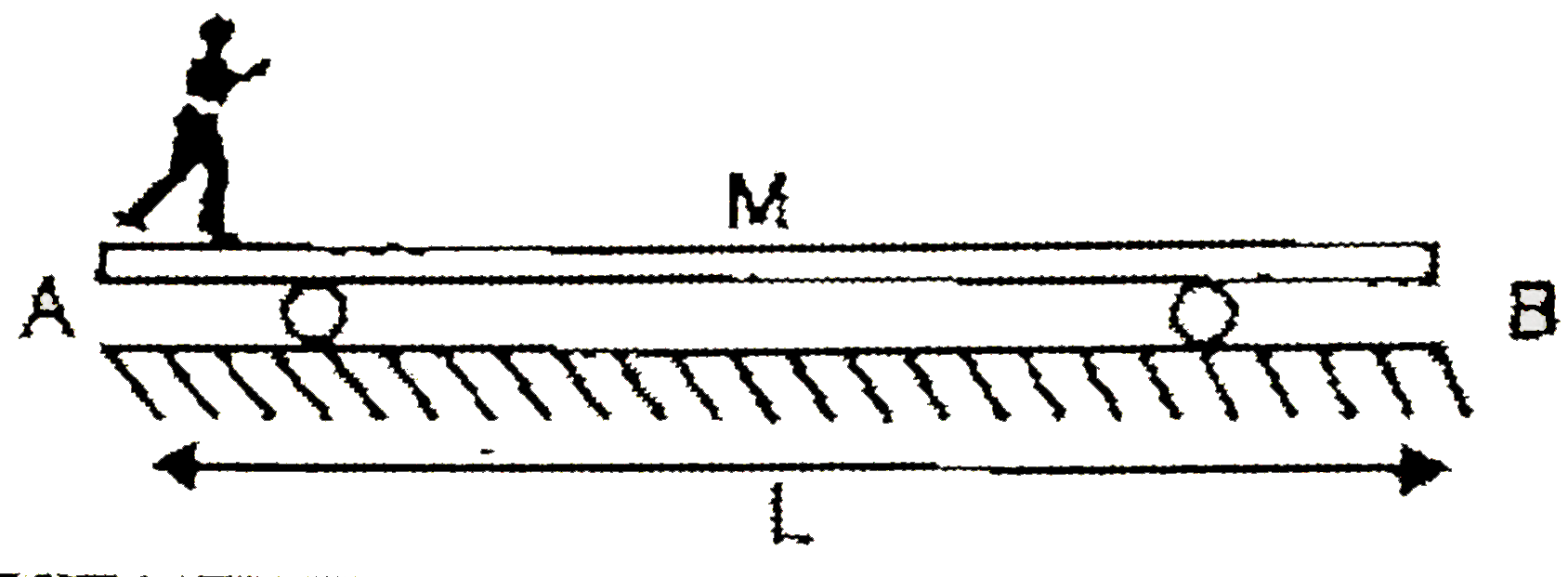A man A is sitting in the rear end of a long compartment of a train running at constant horizontal velocity, tosses a coin to a person B, near the front end of the compartment. The trajectory of the coin is, as seen by B and a person C on the ground, will have:
different vertical ranges, but equal horizontal ranges
equal horizontal an equal vertical ranges
equal vertical ranges but different horizontal range
different vertical and different horizontal ranges
The correct Answer is:C
To solve the problem of the trajectory of the coin tossed from person A to person B in a train compartment, we can analyze the situation step by step.
Step 1: Understand the Frame of Reference
- Situation: Person A is at the rear end of a train compartment, and person B is at the front end. The train is moving with a constant horizontal velocity.
- Frames of Reference: There are two frames to consider:
1. The train's frame (where both A and B are at rest).
2. The ground frame (where the train is moving).
Hint: Identify the different frames of reference involved in the problem.
Step 2: Analyze the Motion in the Train's Frame
- In the train's frame, when person A tosses the coin, it moves vertically upwards and downwards while also having a horizontal component due to the train's motion.
- Since the train is moving at a constant velocity, the horizontal motion of the coin will match the horizontal velocity of the train.
Hint: Consider the effects of the train's constant velocity on the motion of the coin.
Step 3: Analyze the Motion in the Ground Frame
- In the ground frame, while the coin is tossed, it will have two components of motion:
1. Vertical Motion: The coin moves up and then down due to gravity.
2. Horizontal Motion: The coin also moves horizontally at the same speed as the train, which means it will continue to move forward as the train moves.
Hint: Break down the motion of the coin into horizontal and vertical components.
Step 4: Combine the Motions
- The trajectory of the coin, as seen by person B (in the train), will appear as a straight vertical line (up and down).
- However, as seen by person C on the ground, the trajectory will be parabolic. This is because the coin moves forward while it is also going up and then coming down.
Hint: Visualize how the motion appears differently to observers in different frames.
Step 5: Conclusion
- The trajectory of the coin, as observed by person B, is vertical.
- The trajectory of the coin, as observed by person C on the ground, is parabolic.
Final Answer: The trajectory of the coin will be vertical for person B and parabolic for person C.
- Situation: Person A is at the rear end of a train compartment, and person B is at the front end. The train is moving with a constant horizontal velocity.
- Frames of Reference: There are two frames to consider:
1. The train's frame (where both A and B are at rest).
2. The ground frame (where the train is moving).
- In the train's frame, when person A tosses the coin, it moves vertically upwards and downwards while also having a horizontal component due to the train's motion.
- Since the train is moving at a constant velocity, the horizontal motion of the coin will match the horizontal velocity of the train.
- In the ground frame, while the coin is tossed, it will have two components of motion:
1. Vertical Motion: The coin moves up and then down due to gravity.
2. Horizontal Motion: The coin also moves horizontally at the same speed as the train, which means it will continue to move forward as the train moves.
- The trajectory of the coin, as seen by person B (in the train), will appear as a straight vertical line (up and down).
- However, as seen by person C on the ground, the trajectory will be parabolic. This is because the coin moves forward while it is also going up and then coming down.
- The trajectory of the coin, as observed by person B, is vertical.
- The trajectory of the coin, as observed by person C on the ground, is parabolic.
Topper's Solved these Questions
- MOTION IN TWO DIMENSIONBook:A2ZChapter:MOTION IN TWO DIMENSIONExercise:Projection From Inclined Plane
Explore 20 Videos
- MOTION IN TWO DIMENSIONBook:A2ZChapter:MOTION IN TWO DIMENSIONExercise:Relative Velocity In Two Dimensions
Explore 23 Videos
- MOTION IN TWO DIMENSIONBook:A2ZChapter:MOTION IN TWO DIMENSIONExercise:Chapter Test
Explore 29 Videos
- MOCK TESTBook:A2ZChapter:MOCK TESTExercise:Motion With Constant Acceleration
Explore 15 Videos
- NEWTONS LAWS OF MOTIONBook:A2ZChapter:NEWTONS LAWS OF MOTIONExercise:Chapter Test
Explore 30 Videos
Similar Questions
A boy sitting at the rear end of a railway compartment of a train, running at a constant acceleration on horizontal rails throws towards the fore end of the compartment with a muzzle velocity of 20m/sec at an angle 37∘ above the horizontal, when the train is running at a speed of 10 m/sec. If the same boy catches the ball without moving from his seat and at the same height of projection,find the speed of the train at the instant of his catching the ball.
View SolutionIn the figure the top view of a compartment of a train is shown. A man is sitting at a corner 'B' of the compartment . The man throws a ball ( with respect to himself ) along the surface of the floor towards the corner 'D' of the compartment of the train. The ball hits the corner 'A' of the compartment, then find the time at which it hits A after the ball is thrown . Assume no other collision during motion and floor is smooth. The length of the compartment is given 'l' and the train is moving with constant acceleration 'a' in the direction shown in the figure.

View Solution
Knowledge Check
A ball is thrown from rear end to the front end of a compartment of a train which is moving at constant horizontal velocity. An observer sitting in the compartment and another observer standing on the ground draw the trajectory of the ball. They will have
Aequal horizontal and equal vertical rangesBequal vertical ranges but different horizontal rangesCdifferent vertical ranges but equal horizontal rangesDdifferent vertical and different horizontal rangesA train in standing on a platform, a man inside a compartment of a train drops a stone. At the same instant train starts to move with constant acceleration. The path of the particle as seen by the person who drops the stone is:
AparabolaBstraight line for some time & parabola for the remaining timeCstraight lineDvariable path that cannot be definedA person sitting in the rear end of the compartment throws a ball towards the front end. The ball follows a parabolic path. The train is moving with uniform velocity of 20ms−1. A person standing outside on the ground also observers the ball. How will the maximum heights (hm) attained and the ranges (R) seen by thrower and the outside observer compare each other?
Asame hm differente RBsame hm and RCdifferent hm same RDdifferent hm and R
A person standing on a platform finds that a train moving with velocity, 0.6c takes one second to pass by him. Find (a) the length of the train as seen by the person and (b) the rest length fo the train .
View SolutionDirections: Study the following information carefully and answer the Questions given below: Certain number of person is sitting in a row facing towards north direction. Following information is known about them:
Only two persons are sitting between H and C, who is sitting 5th to the right of B. C, is sitting 3rd from the right end. D is sitting at left most end of the row and there are only two persons sitting between D and A. F is sitting just in the middle of A and B and 2nd to the right of A. Not more than two persons are sitting between B and G and G is sitting just next to H. There are only one person is sitting between G and C.
How many persons are sitting to the left of person which is 3rd to the right of H?
View SolutionThe figure shows a man of mass m standing at the end A of a trolley of maas M placed at rest on a smooth horizontal surface. The man starts moving towards the end B with a velocity urel with respect to the trolley. The length of the trolley is L.

When the man reaches the end B, the distance moves . by the trolley with respect to ground is:
View SolutionDirections: Study the following information carefully and answer the Questions given below: Certain number of person is sitting in a row facing towards north direction. Following information is known about them:
Only two persons are sitting between H and C, who is sitting 5th to the right of B. C, is sitting 3rd from the right end. D is sitting at left most end of the row and there are only two persons sitting between D and A. F is sitting just in the middle of A and B and 2nd to the right of A. Not more than two persons are sitting between B and G and G is sitting just next to H. There are only one person is sitting between G and C.
how many persons are sitting in the row?
View SolutionDirections: Study the following information carefully and answer the Questions given below: Certain number of person is sitting in a row facing towards north direction. Following information is known about them:
Only two persons are sitting between H and C, who is sitting 5th to the right of B. C, is sitting 3rd from the right end. D is sitting at left most end of the row and there are only two persons sitting between D and A. F is sitting just in the middle of A and B and 2nd to the right of A. Not more than two persons are sitting between B and G and G is sitting just next to H. There are only one person is sitting between G and C.
How many persons are unknown in a row out of total members?
View Solution